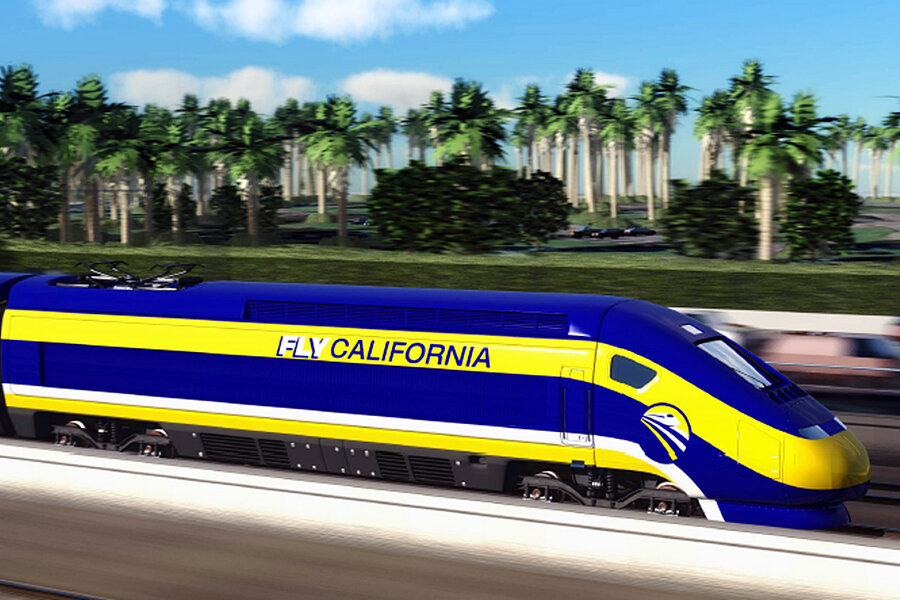California bullet train? How Jerry Brown is at war with himself.
| Los Angeles
California Gov. Jerry Brown's own political spokesman, Dan Newman, has called his boss, "the cheapskate who also thinks big," and nowhere is this more apparent today than in his avowed dream to build a bullet train for the Golden State.
This week. with the state’s unemployment rate down (8.7 percent) and tax revenues up, at least temporarily, Governor Brown is moving ahead with a project that will either place California in the vanguard of a transportation revolution for the 21st century – or push it off a cliff into the financial abyss. Analysts are watching to see if Brown can meld his two personas successfully in an election year, or if he self-destructs in the attempt.
Supporters say Brown’s new twist at funding the bullet train is Brown at his visionary, politician-of-experience best. Detractors say this is just the dangerous kind of sleight-of-hand that Brown, appealing to voters in 2010, promised he wouldn’t pull.
The good news for the governor is that administration officials now expect a $4.2-billion state budgetary surplus by the end of June – as opposed to the $26.6-billion deficit Brown encountered when he took office in 2011. Brown last week admonished state voters and legislators that it is time to be frugal with the slight increase, rather than spend it profligately as in the past. But at the same time, he has proposed a new way to temporarily fund the state’s bullet train, which has been losing public support ever since voters approved a bond measure (Prop. 1A) for the idea in 2008.
“Jerry Brown is at war with himself on public finance. On the one hand he has said that the good budgetary news could be fleeting,” says Jack Pitney, professor of government at Claremont McKenna College. “On the other hand, he is committing to a project that assumes that the money will keep rolling in.”
The proposed $68-billion high-speed rail system's finances have become increasingly uncertain in recent weeks.
In a December legal ruling, the California High Speed Rail Authority lost the ability to tap $9 billion in state bond funds. Brown then proposed collecting millions in fees from businesses that exceed greenhouse gas emissions, known as cap-and-trade funds. Republicans and environmentalists oppose that plan, saying it may be illegal, in that the cap-and-trade exchange grew out of the state’s landmark global warming law in 2006 and should be dedicated solely to reducing the state’s emissions 20 percent by 2020.
Brown responded last week in a budget meeting with comments he has made several times before, comparing the train project to building the Golden Gate Bridge, the transcontinental railroad and the Panama Canal, all of which he said faced "criticisms, skepticism, and attack."
Such a project is needed, he said, to unite a wildly diverse state.
"It reduces greenhouse gases, it ties our California together. We are divided in many respects: north and south, the coast and the center of the state. We have to pull together to form a greater community, and the high-speed rail serves all of those functions," Brown told reporters.
But several detractors have come forward.
Republican Sen. Andy Vidak (R) of Hanford, says that since the passage of Prop. 1A in 2008, voters have learned the project will not be able to meet its original goals, and points out that a recent LA Times poll found that 52 percent of Californians are now opposed to the project and 70 percent want a re-vote.
The source of the objections outlined by Senator Vidak range from a ballooning price tag (from $33 billion in 2008 to $100 billion and beyond) and slower travel, to revised routes that move the bullet train from existing travel corridors and put farms and businesses in its path.
Other prominent Republicans have joined with Vidak.
The actual cost of the bullet train will exceed $100 billion “and maybe even $200 billion by the time it is eventually built,” asserts Gary Aminoff, founder of the San Fernando Valley Republican Club, calling the project “a huge ‘boondoggle’ that the state can ill afford” and that “very few people will use.”
While Brown’s Democratic Party controls both houses of the Legislature, analysts say Brown has an uphill fight.
“To pay for this bullet train, Brown is going to have to trot out yards of political capital,” says David McCuan, professor of political science at Sonoma State University.
“He'll have to ask legislators to suspend their beliefs about re-investing in their own projects and their own priorities that were cut extensively since 2007. This train is really about two things – building that visionary project and getting California's fiscal house in order,” says McCuan. “Can he push the naysayers and nitpickers in the Legislature far enough along to deliver this project to California remains an open question. Things like reelection, a drought, and a burgeoning prison population might stand in the path of that high-speed train.”
Other analysts say more independent information is needed before voters and legislators can make an informed decision.
“What has not been done is to have a credible, third-party research organization look at these two questions,” says Michael Shires, a professor of public policy at Pepperdine University. “So far, there are just the state’s estimates and their critics. The taxpayers need to have credible answers to these question before deciding if it is really worth the price. The governor asserts it is so, but so far there hasn’t been a credible third-party analysis to really confirm if that is true.”








